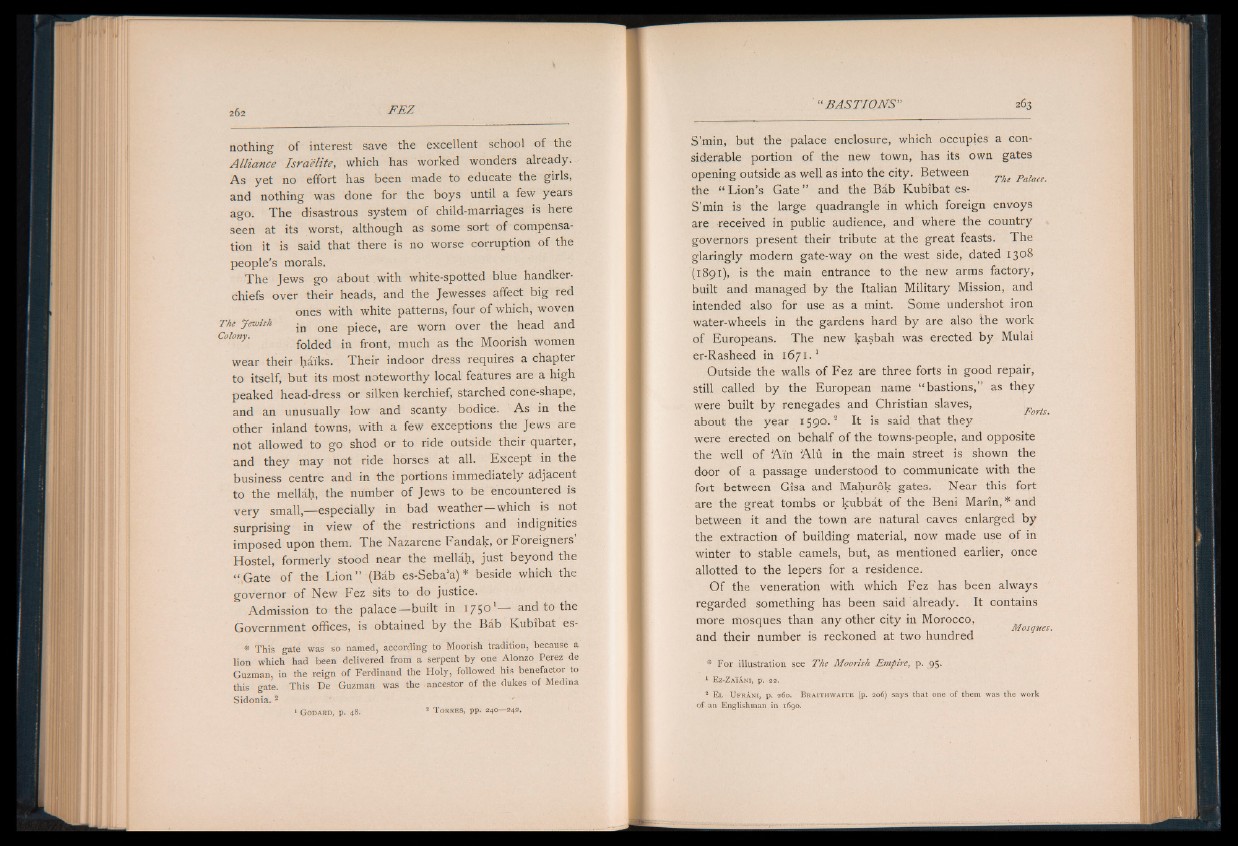
2Ô2 FE Z
nothing of interest save the excellent school of the
Alliance Israélite, which has worked wonders already.
As yet no effort has been made to educate the girls,
and nothing was done for the boys until a few years
ago. The disastrous system of child-marriages is here
seen at its worst, although as some sort of compensation
it is said that there is no worse corruption of the
people’s morals.
The Jews go about with white-spotted blue handkerchiefs
over their heads, and the Jewesses affect big red
ones with white patterns, four of which, woven
The Jewish jn Qne pjec£) are worn over the head and
folded in front, much as the Moorish women
wear their haiks. Their indoor dress requires a chapter
to itself, but its most noteworthy local features are a high
peaked head-dress or silken kerchief, starched cone-shape,
and an unusually low and scanty bodice. A s in the
other inland towns, with a few exceptions the Jews are
not allowed to go shod or to ride outside their quarter,
and they may not ride horses at all. Except in the
business centre and in the portions immediately adjacent
to the mellâh, the number of Jews to be encountered is
very small,— especially in bad weather— which is not
surprising in view of the restrictions and indignities
imposed upon them. The Nazarene Fandak, or Foreigners’
Hostel, formerly stood near the mellâh, just beyond the
“ Gate o f the L ion ” (Bab es-Seba’a) * beside which the
governor of New Fez sits to do justice.
Admission to the palace— built in 175° ’— an<^ to t^ie
Government offices, is obtained by the Bâb Kubibat es-
* This gate was so named, according to Moorish tradition, because a
lion which had been delivered from a serpent by one Alonzo Perez de
Guzman, in the reign of Ferdinand the Holy, followed his benefactor to
this gate. This De Guzman was the ancestor of the dukes of Medina
Sidonia. 2
* G o d a r d , p . 48. 2 T o r r e s , p p . 240— 242.
“ B A ST ION S ” 263
S ’min, but the palace enclosure, which occupies a considerable
portion of the new town, has its own gates
opening outside as well as into the city. Between ' Palace
the “ Lion’s Gate” and the Bab Kubibat es-
S'min is the large quadrangle in which foreign envoys
are received in public audience, and where the country
governors present their tribute at the great feasts. The
glaringly modern gate-way on the west side, dated 1308
(1891), is the main entrance to the new arms factory,
built and managed by the Italian Military Mission, and
intended also for use as a mint. Some undershot iron
water-wheels in the gardens hard by are also the work
of Europeans. The new Ijasbah was erected by Mulai
er-Rasheed in 16 7 1 .1
Outside the walls of Fez are three forts in good repair,
still called by the European name “ bastions,” as they
were built by renegades and Christian slaves,
about the year 1590.2 It is said that they
were erected on behalf of the towns-people, and opposite
the well of Ain Alu in the main street is shown the
door of a passage understood to communicate with the
fort between Gisa and Mahurok gates. Near this fort
are the great tombs or kubbat of the Beni Marin, * and
between it and the town are natural caves enlarged by
the extraction of building material, now made use of in
winter to stable camels, but, as mentioned earlier, once
allotted to the lepers for a residence.
O f the veneration with which Fez has been always
regarded something has been said already. It contains
more mosques than any , other city in M, orocco, Mosques
and their number is reckoned at two hundred
* For illustration see The Moorish Empire, p. 95.
1 E z -Z a 'ia n i , p. 22.
2 E l U f r a n i , p . 260. B r a i t h w a i t e (p. 206) says that one of them was the work
of an Englishman in 1690.